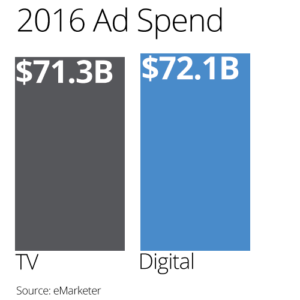To be effective, digital-savvy marketers must answer two key questions:
- Is my digital media working? Is it placed on the right platforms? At the right times? Etc…
- Is my digital creative effective? Am I running the right ads, using the right colors, right copy, etc?
There is an entire cottage industry dedicated to answering the first question – does my digital media work? Everything from viewability, common metrics, verification, industry metrics, ROI modeling, and more dominate the headlines. Last month, Procter & Gamble’s Chief Brand Officer, Mark Pritchard, set off a firestorm within the ad community when he essentially told the ad industry to clean up its act, and announced strict requirements for his brands that directly impact industry-standard viewability metrics, fraud protection and third-party verification.
I believe the message only addresses one side of digital advertising.
If your digital media metrics are considered ‘good,’ but your creative fails to engage and motivate your intended audience – what’s the point?
Think about it, the digital creative testing industry hasn’t changed much over the years, and it certainly hasn’t kept pace with the evolution of advertising and digital media. There are essentially three way to test your creative in today’s modern, digital world:
“For Twitter and Facebook campaigns, “it’s very tough to test just because of the volume of content we are putting out.”
Ram Krishnan, CMO, Frito Lays, in AdAge
Traditional Copy Testing
This tried and true method simply doesn’t match the speed required to meet the demands of digital– especially social marketing.
A/B Testing
Okay, we all love A/B testing and we leverage it ourselves every day AdParlor, but it’s not a decision maker for ‘why’ something works. It will give you a sense of ‘what’ works, but never touches on ‘why’. The result? Ads are getting pushed out that are not tested, resources are wasted, and there are no learnings gathered to help inform creative for future campaigns.
Facebook Brand Lift
It’s a fantastic tool from Facebook, but it only looks at awareness, intent and how the ads are resonating with audiences. But, doesn’t give any insight into what’s performing well or why.
 The problem is exacerbated time and time again as more media– and media spend— is going digital. According eMarketer, US spending on digital ads surpassed spending on traditional TV ads for the first time in 2016.
The problem is exacerbated time and time again as more media– and media spend— is going digital. According eMarketer, US spending on digital ads surpassed spending on traditional TV ads for the first time in 2016.
And so, I’d like to break from tradition a bit here and tell you about a new AdParlor feature that helps solve for these problems: AdParlor Intelligence Tags™, or Intel Tags for short.
What are Intel Tags? Intel Tags use artificial intelligence to automatically tag and test the effectiveness of a variety of elements across a range of social ads, such as images, videos, .GIFs, cinemagraphs, copy and canvas ads. It leverages deep learning so the platform can continue to improve the automatic tags it applies with ongoing usage.
The goal is to take the guess work out of knowing why a piece of creative works. Answer the ‘why’, and you’ll also answer the ‘what.’ Then, you’ll finally be that smart, digital-savvy marketer your mother-in-law always wished you were.
Basically, any asset added to the platform is automatically tagged after the system performs a visual analysis. Currently, there are tens of thousands of elements the system can recognize automatically. Everything from forest to ocean, train to highway, and everything in between. Advertisers can add their own custom tags too for things they care about. Blue text, green text, sunset, rainforest, shoes, sunglasses, no copy, script copy and so on.
 That’s the hard part. Then the fun part starts. The platform will provide insights for all the tags so the advertiser can finally make smart decisions about ‘why’ something is working. It will be clear that shoes as an accessory performed better than sunglasses, and that blue backgrounds outperformed red backgrounds. You can also test what copy resonates along with any number of other things.
That’s the hard part. Then the fun part starts. The platform will provide insights for all the tags so the advertiser can finally make smart decisions about ‘why’ something is working. It will be clear that shoes as an accessory performed better than sunglasses, and that blue backgrounds outperformed red backgrounds. You can also test what copy resonates along with any number of other things.
Other ways to use Intelligence Tags:
- Test scenery: indoor, outdoor, backgrounds, etc.
- Test typography, colors, fonts, sizes, placements
- Test accessories, products, layouts
- Test focal points: single product, multiple products
- Test lifestyle imagery
- Test sales promotions: percentage discounts, no percentage discounts.
- CTAs: with a CTA, without
- Viewability for videos: View time with sound, without, etc.
Great, right?
Currently Intel Tags work for campaigns running across Facebook and Instagram, but will be available across other social platforms, such as Pinterest and Snapchat, within the AdParlor platform.
Visit our Intelligence Tags page to learn more or to check out a case study that highlights how a major online retailer leveraged Intelligence Tags to improve its campaign and creative performance.

